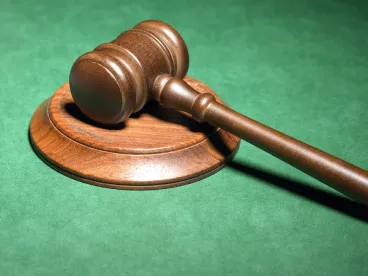In Campbell Soup Co. v. Gamon Plus, Inc., Nos. 20-2344 and 21-1019 (Fed. Cir. Aug. 19, 2021), the Court of Appeals for the Federal Circuit (“Federal Circuit”) reversed the Final Written Decisions in two inter partes reviews (“IPRs”), IPR2017-00091 and IPR2017-00094. In the IPRs, the Patent Trial and Appeal Board (“the Board”) concluded that the petitioner (Campbell) did not demonstrate that Gamon’s claimed designs in U.S. Design Pat. Nos. D612,646 and D621,645, were unpatentable as obvious.
Background
The patents at issue relate to a gravity feed dispenser display for canned products, such as soup. Gamon sued Campbell for infringement in 2015, and Campbell subsequently petitioned for IPR. The Board held Campbell failed to prove the challenged claims were unpatentable because the asserted prior art reference, Linz, was not similar enough to constitute a primary reference. Id. at *7.
The Federal Circuit disagreed, vacated, and remanded.
On remand, the Board again found Campbell failed to prove unpatentability. According to the Board, “although Linz alone has the same overall visual appearance as the claimed designs, it is outweighed by objective indicia of nonobviousness, namely [commercial success, industry praise, and copying].” Id. The Board presumed a nexus between the objective evidence and the claimed designs because it found that Gamon’s product was coextensive with its claims. Id. The Board also found that Gamon established nexus-in-fact “regardless of the presumption.” Id.
Federal Circuit Decision
For design patents as with utility patents, the obviousness analysis starts by addressing the first three Graham factors. For design patents, this means determining “whether a designer of ordinary skill would have combined teachings of the prior art to create ‘the same overall visual appearance as the claimed design.’” Id. at *8. The Board “found that Linz and the claimed designs share the same overall visual appearance.” Id. at *10. The Federal Circuit did not disturb the Board’s conclusion with respect to this determination.
The obviousness analysis must next consider the fourth Graham factor, objective indicia of nonobviousness, such as commercial success, long felt but unmet needs, and failure of others. Id. at *8. To be probative, the evidence of objective indicia of nonobviousness must have a “nexus” to the claims, i.e., “there must be a legally and factually sufficient connection between the evidence and the patented invention.” Id. at *10. A nexus may be presumed if the evidence is tied to a specific product that is “coextensive” with the claimed invention, meaning that the product “is the invention disclosed and claimed.” Id. (emphasis in original). Absent the presumption, a patentee may still establish nexus-in-fact by showing that the objective indicia are the “direct result of the unique characteristics of the claimed invention,” rather than features known in the prior art. Id. at *11. In this case, the Federal Circuit found that substantial evidence did not support the Board’s finding of either a presumption of nexus or nexus-in-fact between the evidence of commercial success and praise and the claimed designs. Id. at *10.
According to the Federal Circuit, the Board misunderstood the law with respect to the coextensiveness required for a presumption of nexus when it dismissed the unclaimed features of the design as “not prominent ornamental features.” Id. at *11. The Federal Circuit explained:
In determining coextensiveness, the question is not whether unclaimed features are insignificant to a product’s ornamental design. The question is instead whether unclaimed features are “insignificant,” period. … By limiting its analysis to ornamental significance, the Board simply did not answer the relevant question: whether the iQ Maximizer “is the invention.”
Id. at *11 (emphasis in original).
The Federal Circuit noted that the type of patent (utility or design) does not impact the coextensiveness analysis. “[W]e reject the proposition that a product satisfies the coextensiveness requirement in the design patent context merely if its unclaimed features are ornamentally insignificant.” Id. (emphasis in original).
Applying the correct legal standard, the Federal Circuit found a lack of coextensiveness between the product sold and the claimed design prohibited the presumption of a nexus. The product sold “undisputedly includes significant unclaimed functional elements.” Id.
The Federal Circuit went on to find substantial evidence did not support a nexus-in-fact either. The Federal Circuit again noted that the type of patent did not impact the analysis and that, whether the patent is a design or a utility patent, the objective indicia evidence must have a nexus with the unique characteristics of the claims at issue. Id. at *14.
Applying the correct legal standard, the Federal Circuit found that the evidence presented as to commercial success and industry praise related to features previously known in the prior art rather than features of the claims that had been found to be new and unique, and thus did not support a nexus-in-fact. Id. at *12-13.
Finally, the Federal Circuit considered evidence of copying but found that, even if the evidence of copying was assumed to be supported, it was insufficient alone to outweigh the strong evidence of obviousness. Id. at *14-15.
Takeaways
The decision in Campbell Soup provides a reminder to patent owners that objective evidence is only valuable if a nexus is established with the claimed subject matter. The decision also highlights that the legal analyses to determine coextensiveness and nexus-in-fact do not depend on the type of patent, and that the analyses for design patents are the same as for utility patents. Courts and the Board are looking for causation between the objective evidence and the merits of the claimed invention. A mere correlation may not be sufficient.
Patent Owners should consider loading evidence into prosecution, along with crisp and compelling arguments to show no prima facie case of obviousness, at least in applications likely to end up in litigation or AIA post-grant proceedings. Solid evidentiary showings and/or declarations, in addition to on-point legal arguments, may help to develop strong patentability records. Prudently establishing such records during prosecution could support Patent Owner’s later efforts to persuade the Board that Petitioner does not have a “reasonable likelihood” of success and thus achieve denial of institution.
Submission of this evidence requires careful thought and planning. Evidence or a declaration thrown together in haste, or otherwise considered defective, may even be harmful rather than helpful.[1]Additionally, the evidence must be truthful and not misleading, as inequitable conduct is still alive and well post-Therasense.
If, as a Patent Owner, you are fortunate to have good objective evidence of nonobviousness, then it is worth the effort to present that evidence and explain the nexus between that evidence and the new and unique merits of the claimed invention to the Board in detail. The best objective evidence of nonobviousness will be of no value if no nexus to the claimed invention is shown.
[1]See, e.g., K-40 Electronics, LLC v. Escort, Inc., IPR2013-00203, Paper 6, at 6 (P.T.A.B. Aug. 29, 2013) (instituting IPR based on defective declaration submitted during prosecution).




 />i
/>i

